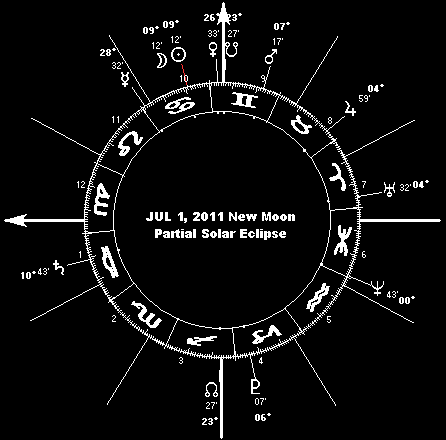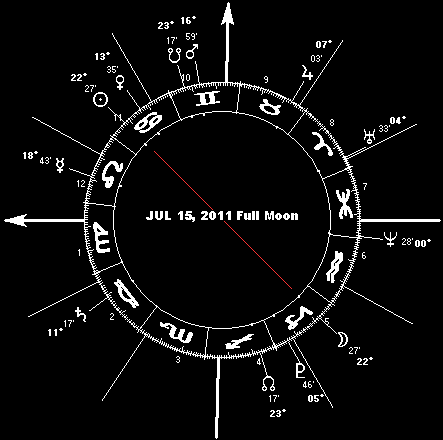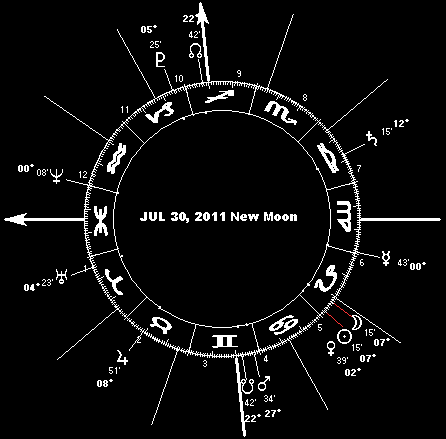If you were expecting some kind of sun sign nonsense, forget about it. This is real astrology for the real world, not some mystical mumbo-jumbo word salad. If it's real astrology for yourself that you want, you can get it by phone or in print. And if you need help deciphering the astrological glyphs in the graphics accompanying this article, see Astroglyphs: Astrological Symbols Guide. Please note: this forecast is expressed in terms of Universal Time (UT). Also please be aware that, while I never change a forecast once it's published, I do post errata to acknowledge typographical errors and the like.
You can never plan the future by the past.
-- Edmund Burke
 As mentioned both in my 2011 World Forecast Highlights and in my June online forecast, the July 1 partial solar eclipse at 9° 12 Cancer is already in effect as July opens. That's because a solar eclipse has an effective shock window that extends seven days (degrees of solar travel) either side of the exact moment of the eclipse. (Debunkers - which is to say pseudo-skeptics - who gasp at seven days are protesting a mote when they have a log in their eyes.) This particular eclipse falls in the middle of the Antarctic Ocean, and so will be seen only by more or less fanatical eclipse-chasers. Its the first in the Saros 156 series, which runs to the year 3237. Making a Grand Cross in the heavens, the eclipse opposes Pluto, and is squared by the Saturn-Uranus opposition. Being a solar eclipse, it has a shock window that runs from June 25 to July 8, with critical peaks around June 29 (the Moon reaching maximum declination north of the celestial equator), as well as July 1 and 6 (the day the Moon crosses the celestial equator headed south). In terms of mass psychology, this is a time when the fear of loss is amplified. As I wrote last year in my forecast for this alignment, "another debt crisis is likely under the aegis of the July 1 eclipse, and thats a fairly solid indicator of a certain level of panic in the equity markets. People look for safe harbors at times like this, financially speaking: toward precious metals, away from vulnerable currencies." This is more than a financial panic and debt crisis story, however. The Saturn-Uranus opposition factor is a sign of social, political and cultural foment on top of financial and economic upheaval.
As mentioned both in my 2011 World Forecast Highlights and in my June online forecast, the July 1 partial solar eclipse at 9° 12 Cancer is already in effect as July opens. That's because a solar eclipse has an effective shock window that extends seven days (degrees of solar travel) either side of the exact moment of the eclipse. (Debunkers - which is to say pseudo-skeptics - who gasp at seven days are protesting a mote when they have a log in their eyes.) This particular eclipse falls in the middle of the Antarctic Ocean, and so will be seen only by more or less fanatical eclipse-chasers. Its the first in the Saros 156 series, which runs to the year 3237. Making a Grand Cross in the heavens, the eclipse opposes Pluto, and is squared by the Saturn-Uranus opposition. Being a solar eclipse, it has a shock window that runs from June 25 to July 8, with critical peaks around June 29 (the Moon reaching maximum declination north of the celestial equator), as well as July 1 and 6 (the day the Moon crosses the celestial equator headed south). In terms of mass psychology, this is a time when the fear of loss is amplified. As I wrote last year in my forecast for this alignment, "another debt crisis is likely under the aegis of the July 1 eclipse, and thats a fairly solid indicator of a certain level of panic in the equity markets. People look for safe harbors at times like this, financially speaking: toward precious metals, away from vulnerable currencies." This is more than a financial panic and debt crisis story, however. The Saturn-Uranus opposition factor is a sign of social, political and cultural foment on top of financial and economic upheaval.
Saturn-Uranus oppositions, as described in the World Forecast Highlights Ive published annually since 2007, "have heralded what Ive called a harbinger of panic in the markets, panic in the streets, people in need of rescue, just a whiff of revolution in the air. Per my forecasts, these things have been much in evidence these past couple years, from strikes and riots in the streets of Athens, Paris, London, Port-au-Prince and Tehran to debt crises and wild swings in equity markets worldwide; into precious metals and away from threatened bonds and currencies; to the unemployment and foreclosure crises here in the States. This is still far from over, theres bound to be more public unrest on and off throughout 2011 particularly under the aegis of the Mars factors at work in the spring, summer and late fall of the year . . . "
 Anyone whos followed the news lately knows that debt crises are mounting everywhere, from individuals out of work and out on the streets to local and state governments and even the federal government here in the States, to similar situations here and there around the world. These economic crises have led governments to first try to maintain various social safety nets, and then to abandon those palliatives when the expense overwhelmed the governments in debt. Strikes, demonstrations, riots and rebellions have been and still are sweeping across the world. Its all in the forecast I published last year and in the headlines today. Its not over yet, by a long shot. And as Ive indicated, this is far from a desperate Third World phenomenon. North Africa and the Middle East have been a focus of headlines just about all year, but there are also strikes and demonstrations in Europe, Asia and the US. If Im right in maintaining that this economic transition isnt over until 2020 which is what Ive written for several years now then theres more of this to come for quite some time yet. In fact, there are reasons to believe that economic matters will be a bigger subject of concern in the second half of 2011 than the first.
Anyone whos followed the news lately knows that debt crises are mounting everywhere, from individuals out of work and out on the streets to local and state governments and even the federal government here in the States, to similar situations here and there around the world. These economic crises have led governments to first try to maintain various social safety nets, and then to abandon those palliatives when the expense overwhelmed the governments in debt. Strikes, demonstrations, riots and rebellions have been and still are sweeping across the world. Its all in the forecast I published last year and in the headlines today. Its not over yet, by a long shot. And as Ive indicated, this is far from a desperate Third World phenomenon. North Africa and the Middle East have been a focus of headlines just about all year, but there are also strikes and demonstrations in Europe, Asia and the US. If Im right in maintaining that this economic transition isnt over until 2020 which is what Ive written for several years now then theres more of this to come for quite some time yet. In fact, there are reasons to believe that economic matters will be a bigger subject of concern in the second half of 2011 than the first.
For one thing, the Venus Max cycle that began last year heralded, as predicted, a time of relative economic growth. US Federal Reserve Chairman Ben Bernanke announced the Feds QE2 (follow-up Quantitative Easing economic stimulus program) at a speech in Jackson Hole, Wyoming on August 27, 2010 exactly one week after the start of the 2010-2011 Venus Max cycle. Subsequently, there was a marked improvement in major equity markets and economic activity in the US and in many parts of the world. It started with a triple-digit gain in the Dow Jones Industrial Average (DJI) the next trading day after the Jackson Hole conference, and it was upward and onward right up until a couple months after the end of the Venus Max cycle in January 2011 (allowing for the customary profit-taking pull-backs and other normal fluctuations). This is exactly as I described in advance in my World Forecast Highlights (published the previous year):
Just remember that the current Venus Max ends early in 2011. It has a certain amount of inertia, so there wont be an immediate crash and burn in its aftermath. But like a rocket that continues its upward arc for some time after the fuel burns out, inertia can only carry so far.
In this case, I figure it probably carries until sometime in March, when the last exact Jupiter-Saturn opposition of the current series occurs. The two giant planets are within just a few degrees of their March 28 exact alignment from mid-March into very nearly the middle of April, so the tipping point can happen anywhere in this range and still be very much on schedule.
 Look at the DJI, for example. See how it rose from summer of 2010 (start of the Venus Max), dropped sharply in March, and then oscillated in a trading range from March until now at which time its trading within points of its March peak. What happens next? Lets just say that whatever inertia the Venus Max had is pretty well spent now, and virtually all used up by the time of the August 16 Venus- Sun conjunction. And there wont be another Venus Max getting underway until March 27 next year. Im no Chicken Little; I am invested in the markets. But Im more than 50% in cash now, because Im expecting more opportunities to buy well than sell well in the months to come and lots of juicy high-yield dividend-paying stocks to be selling at a healthy discount over the same time period. And of course, theres always precious metals on the pull-backs . . . but enough of "the dismal science" . . .
Look at the DJI, for example. See how it rose from summer of 2010 (start of the Venus Max), dropped sharply in March, and then oscillated in a trading range from March until now at which time its trading within points of its March peak. What happens next? Lets just say that whatever inertia the Venus Max had is pretty well spent now, and virtually all used up by the time of the August 16 Venus- Sun conjunction. And there wont be another Venus Max getting underway until March 27 next year. Im no Chicken Little; I am invested in the markets. But Im more than 50% in cash now, because Im expecting more opportunities to buy well than sell well in the months to come and lots of juicy high-yield dividend-paying stocks to be selling at a healthy discount over the same time period. And of course, theres always precious metals on the pull-backs . . . but enough of "the dismal science" . . .
Last months forecast reminded you to "keep your eyes open and your wits about you in the days surrounding a week before and after the June 24 opposition from the Red Planet to the degree of the November 25, 2011 solar eclipse. This is one of those if it bleeds, it leads periods, roughly a fortnight (from around June 17 through July 1) when martial behavior and all the rest of the Red Planet stuff belligerence, clashes personal and social (from assault to murder to riots in the street), military and paramilitary attacks (including terrorism), fires, crashes and explosions will emerge from their normal background levels into headline prominence. The most recent high Mars episodes like this occurred within days either way of last months (May 1) Mars-Jupiter conjunction. If that date sounds familiar, think Abbotobad, Pakistan; and remember that all major Mars factors indicate, as described in my 2011 World Forecast Highlights, a period of elevated tension and conflict, the kind of atmosphere that cultivates inflamed passions, hot tempers and rash, even violent action - of the criminal and military type, from terrorist atrocities to large scale military conflict." July 1 brings us to the end of this particular risk window, but it aint over til its over, so dont throttle back just yet. There are several other red-flag Mars phases this month, enough to keep the heat on pretty much throughout July: theres July 6 for example (Mars at the degree of the June 1 solar eclipse), July 17 (Mars on the December 10 lunar eclipse degree), and July 26 (Mars opposite the June 15 lunar eclipse degree). Look over the headlines of the last couple weeks, from fires, crashes and clashes to street riots to suicide bomber attacks to garden variety homicides: the heavy concentration continues on and off throughout most of July. And remember that these Mars factors have an effective range of plus or minus 4-5 days. (This is not to say that peace will break out all over the day a Mars factor abates; only that the general level of murder and mayhem should taper off to something approaching a more normal level.)
 As for the storm and seismic potential of the July 1 solar eclipse, expect the usual during the June 25-July 8 geocosmic shock window: powerful storms with damaging winds and heavy precipitation, moderate-to-severe seismic activity (magnitude 5 and up earthquakes, plus the occasional tsunami and an up-tick in volcanic eruptions). Where? Nowhere is beyond the reach of these stirrings in Earths crust, seas and atmosphere. But astro-locality mapping suggests that western Russia, the Middle East and east Africa are among the riskier zones, along with a longitudinal arc from Alaska due south through the Pacific Ocean. Theres also a suspicious-looking horizon arc sweeping across Western Australia, New Guinea and Indonesia, through the Pacific to traverse Kamchatka, the Bering Strait and Alaska, crossing from there through northern Canada and the US Northeast, crossing the Atlantic southeasterly to touch eastern Brazil.
As for the storm and seismic potential of the July 1 solar eclipse, expect the usual during the June 25-July 8 geocosmic shock window: powerful storms with damaging winds and heavy precipitation, moderate-to-severe seismic activity (magnitude 5 and up earthquakes, plus the occasional tsunami and an up-tick in volcanic eruptions). Where? Nowhere is beyond the reach of these stirrings in Earths crust, seas and atmosphere. But astro-locality mapping suggests that western Russia, the Middle East and east Africa are among the riskier zones, along with a longitudinal arc from Alaska due south through the Pacific Ocean. Theres also a suspicious-looking horizon arc sweeping across Western Australia, New Guinea and Indonesia, through the Pacific to traverse Kamchatka, the Bering Strait and Alaska, crossing from there through northern Canada and the US Northeast, crossing the Atlantic southeasterly to touch eastern Brazil.
The solar eclipse is by far the preeminent, but by no means the only geophysical stress signal this month. Others include full moon at 22° 27 Capricorn on the 15th, in effect from the 11th (in advance of the lunar south declination peak on the 12th) into the 20th (following the Moons northward crossing of the celestial equator on the 19th). And then theres the July 30 new moon, with a shock window that stretches from the 26th (the day before the north lunar declination peak on the 27th) into August 3rd (the day after the lunar perigee). These are periods of enhanced geophysical stress, raising the likelihood of newsworthy strong storms with damaging winds and heavy precipitation, as well as moderate-to-severe seismic activity (magnitude 5+ earthquakes, possibly including subsequent tsunami, as well as volcanic eruptions.)
In closing, my earlier mention of the once and future Venus Max cycle brings to mind the start of the Mercury Max cycle this month on the 20th, when the little planet reaches its greatest elongation east of the Sun. Its a cycle that continues through the August 3-26 retrograde and the August 17 inferior conjunction, ending with Mercurys maximum western elongation on September 3. Mercury Max, in case you didnt already know it, is the truth about Mercury retrograde. Get ready, stay sharp, take nothing for granted . . . for more, see the appropriate section of my 2011 World Forecast Highlights.
 SPECIAL FEATURE: This month's birthdays of the famous and infamous (with astrological birth charts)
SPECIAL FEATURE: This month's birthdays of the famous and infamous (with astrological birth charts)